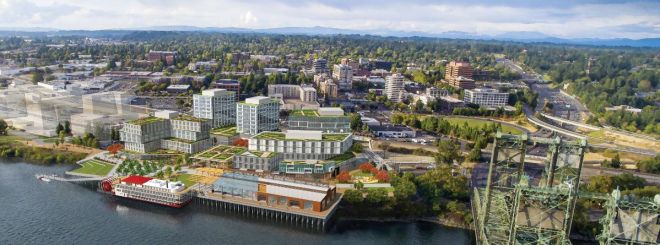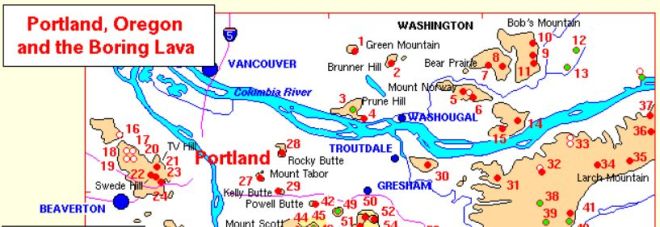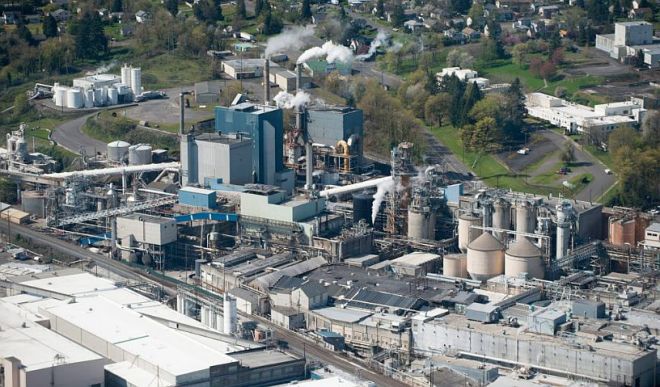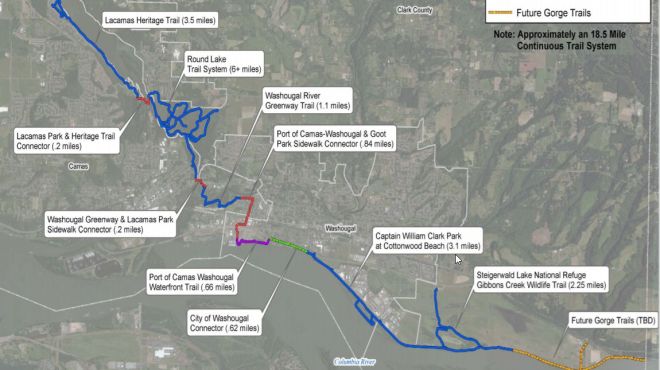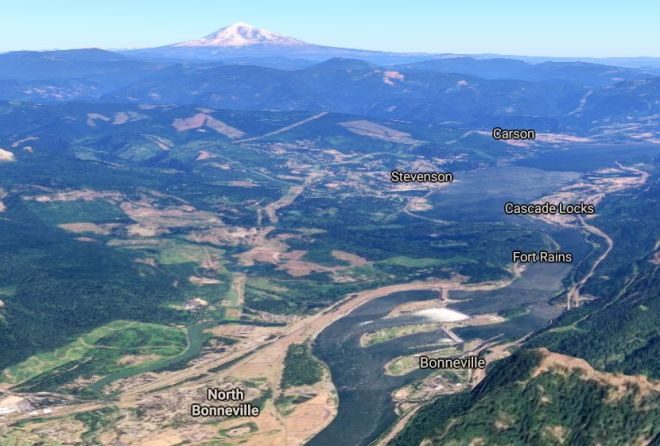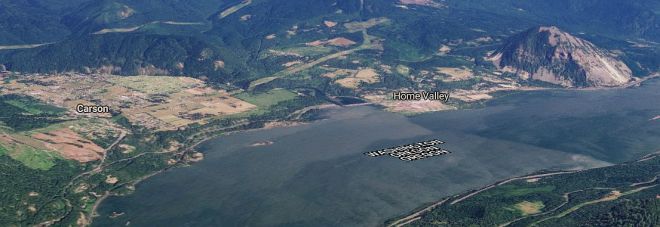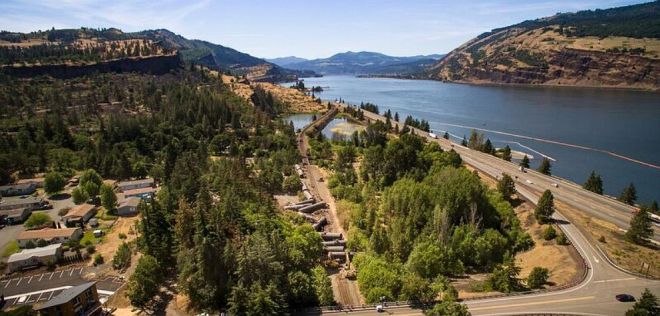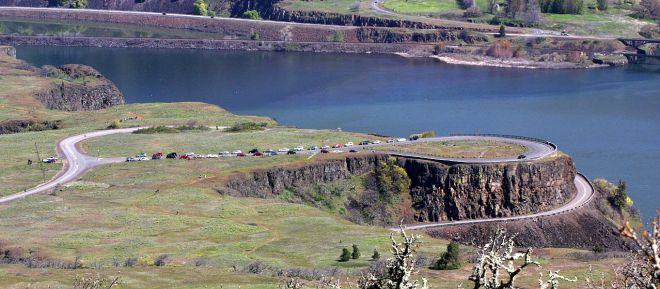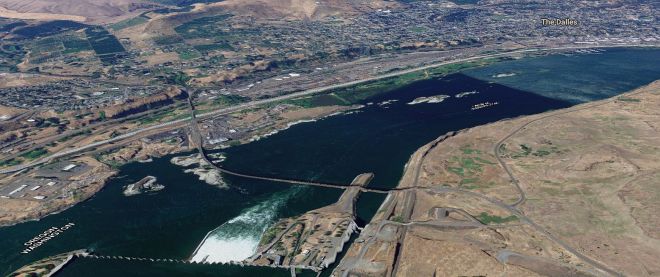- Vancouver, Washington
- Camas, Washington
- Washougal, Washington
- North Bonneville, Washington
- Cascade Locks, Oregon
- Stevenson, Washington
- Carson, Washington
Carson is a small community within Carson River Valley and home to the Carson hot spring and resort, boasting a geothermal steam bath. Native residents had used it as long as 10,000 years ago, according to the resort. The historical hotel was completed in 1901 and is still being used today. The nearby Bonneville Hot Springs Resort and Spa in Skamania County is now home to the Foundations Recovery Network, a drug and alcohol treatment facility.
- Hood River, Oregon
- White Salmon, Washington
- Mosier, Oregon
- Rowena, Oregon
- Lyle, Washington
- The Dalles, Oregon
Vancouver is the fourth largest city in the state, with a population of 180,000, is the county seat of Clark County and forms part of the Portland-Vancouver metropolitan area, the 23rd largest metropolitan area in the United States. The state of Washington levies no individual or corporate income taxes and low property taxes but has a sales tax above the national median. Conversely, Oregon has no sales tax but one of the highest state income taxes. As a result, many Vancouver residents prefer to shop in Hayden Island, while many people with an Oregon job live in Vancouver. Vancouver hosts a Fourth of July fireworks display that draws many people to the city. The Vancouver Columbian is the daily paper.
Camas (pop of 19,000), borders Washougal on the east and Vancouver on the west. One of the major geographical features of the city is Prune Hill, an old volcanic vent and part of the Boring Lava Field of northwest Oregon and southwest Washington which has been extinct for about 300,000 years. At the west end of downtown Camas is a large Georgia-Pacific paper mill, the commercial base of the city. The Heritage Trail along Lacamas Lake is a long continuous nature corridor that receives considerable use.
The Georgia-Pacific mill, a subsidiary of Koch Industries, will shut down several operations at the mill, which opened in 1885 and employed thousands, will soon have just 120 to 140 jobs remaining. “The paper mill is the reason Camas exists,” said Peter Capell, city administrator.
The city of Washougal (pop. 15,000), is 18 miles east of Vancouver on State Route 14. The Port of Camas-Washougal offers a clear view of Mt. Hood to the east and spectacular evening sunsets to the west. The Steigerwald National Wildlife Refuge along the river is a great place for birding while the Washougal River is a great place for fishing. A waterfront trail will complete a trail system that connects with Camas and Washougal and area downtowns, job centers, and
recreation.
The city of North Bonneville in Skamania County, was relocated from the Columbia’s north shore in 1971 when the second Bonneville Powerhouse was built. The relocation project took 7 years and included raising the new town site above the 100-year flood plain, construction of streets, utilities, lighting, water supply and sewage treatment plant, parks, and a central business district.
Both the cascades and the old lock structure were submerged by the Bonneville Reservoir, also known as Lake Bonneville. North Bonneville Heritage Trails highlight four trails, each originating from a central location and branching out through the community. Beacon Rock State Park is to the east.
The City of Cascade Locks, in Hood River County, Oregon, took its name from a set of locks built to improve navigation which were subsequently submerged in 1938, replaced by Bonneville Lock and Dam. Cascade Locks features a Sternwheeler on the Columbia owned by the Port of Cascade Locks and operated by the Portland Spirit.
The Port owns and operates the iconic Bridge of the Gods which serves as a critical transportation connection between the states of Oregon and Washington. Marine Park contains a campground, boat ramp, marina, beach, and historical museum.
The city of Stevenson (pop 1,500) may be best known for the Columbia Gorge Interpretive Center, the Riverside Lodge and Skamania Lodge with its Aerial Park and Zip Line Tour.
Hiking
trails are spectacular and often go through the Gifford Pinchot National Forest. They include the Cape Horn Trail, Dog Mountain trails and Beacon Rock trail.
The City of Hood River in Hood River County, is at the confluence of the Hood River and the Columbia River in the heart of the Columbia River Gorge. The city is about 30 miles (48 km) north of Mount Hood, the tallest peak in the state. It is across the Columbia River from White Salmon, Washington.
South of the city is the Hood River Valley, known for its production of apples, pears, and cherries. Hood River’s economy depends on agriculture, sports recreation such as as a site for world-class windsurfing, and kiteboarding, and high-tech industries, such as drone maker Insitu and Hood Technologies, have become large employers. Visitors may enjoy the History Museum of Hood River and the Western Antique Aeroplane & Automobile Museum (WAAAM). Hood River News has the latest.
The City of White Salmon (pop 2200) is in Klickitat County, on a bluff overlooking the Columbia River, Mt. Hood, and Hood River, Oregon. Hiking, camping and biking opportunities are abundant. Rafting the White Salmon River offers some of the best class III-IV rapids around.
The City of Mosier (pop. 433) in Wasco County, Oregon had a railroad station and was a steamboat landing for boats headed upriver during the late nineteenth century. The town has attracted tourists, many of whom visit the nearby Mosier Twin Tunnels, part of the Historic Columbia River Highway State Trail, which was opened to cyclists and hikers in 2000.
On June 3, 2016, a 96-car oil train derailed near Mosier with 11 cars derailed. At least one caught on fire, only 20 feet away from the city’s sewage treatment facility.
The town of Rowena is an unincorporated community in Wasco County. It’s located west of The Dalles, where the river passes through the natural feature Rowena Gap. There was once a ferry operating between Rowena and Lyle, Washington across the Columbia.
The Historic Columbia River Highway (U.S. Route 30) climbs to the Rowena Crest, where there is an overlook, from the community of Rowena.
The town of Lyle (pop 530) in Klickitat County, Washington had steamboat operations until the North shore railroad was completed. When the SP&S Railway came to town in 1907, its line passed north of the town, closer to the river. The present is near the river while the older ‘downtown’ townsite was built on the hills above the river.
Today Lyle has several popular windsurfing beaches, including Doug’s Beach and is home to six boutique wineries: Cor Cellars, Domaine Pouillon, Jacob Williams Winery, Klickitat Canyon Winery, Memaloose, and Syncline. The Klickitat River, west of town runs 96 miles from northwestern Yakima County and features five boat launches in the area for catching trout and steelhead.
The City of The Dalles (pop. 13,620) is the county seat of Wasco County, Oregon. Starting in the 1810s, it became active in the fur trade with the American Pacific Fur Company (PFC) and the Canadian North West Company (NWC) headquartered here. In 1821 the North West Company was absorbed by the giant London-based Hudson’s Bay Company (HBC). Fort Vancouver, built in 1824, replaced Fort Astoria as the regional fur trade headquarters.
Ben Snipes, Northwest Cattle King, built a flouring mill at The Dalles not far from where his earlier cattle interests lay. Construction of The Dalles Dam in 1957 submerged the Long Narrows and Celilo Falls.
Celilo was the oldest continuously inhabited community on the North American continent. The falls were the sixth-largest by volume in the world and were among the largest in North America. Celilo Falls and The Dalles were strategically located at the border between Chinookan and Sahaptian speaking peoples and served as the center of an extensive trading network across the Pacific Plateau. A small Native American community exists today at nearby Celilo Village, on a bluff overlooking the former location of the falls.
Points of interest include Columbia Gorge Discovery Center, the official interpretive center for the Columbia River Gorge National Scenic Area and the Fort Dalles Museum. In 2006, Google established a major data center, using the area’s reliable hydroelectric power and the underutilized fiber optic capacity of the area.

